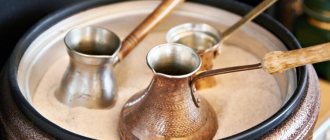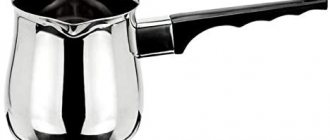The names of vessels for brewing coffee came to us from the East, and these terms came to each European country in different ways. As a result, a situation has arisen where a buyer who wants to purchase a good cezve is faced with very strange names, such as “Turka dalla” or “Ibrik cezve for making Turkish coffee”, “Ethiopian Turk cebena”. It is very easy to get confused, since the illustrations depict completely different objects than one would expect, judging by the signature. Let's figure out what containers for making coffee are and what to call them correctly.
What is coffee usually brewed in?
There is more than one name for cookware for making coffee. In the United States of America alone, about eight hundred patents have been issued for various variations of coffee makers. Essentially, all these devices are divided into two types:
- electrical;
- slab
Slabs require heating. The dishes are placed on the stove. Electric ones simply need to be connected to the mains.
There are both simple devices that have been used for centuries, and modern units that perform many functions, including grinding beans and choosing the optimal dosage.
Cooking in Turk
The oldest and simplest way to prepare a coffee drink, which is still widely used today, is boiling the beans in a Turk (cezve). Already from the name it becomes clear that this dish was invented in eastern countries. They initially used ordinary saucepans to brew the drink, and then for convenience they decided to remove one of the handles. The one that remained was made longer, curved and flattened.
Over time, the Arabs noticed that if the container at the neck was made narrower and the edges widened, the coffee would be much tastier. Thus, dishes with a thickened bottom, a narrow neck and a long handle were invented. She quickly gained popularity all over the world.
Nowadays, Turkish coffee is prepared on a stove (gas or electric). The classic recipe involves brewing in hot sand. The following actions are performed:
- The sand is heated for several hours.
- A Turk filled with coffee and water is immersed in it up to the level of the neck.
- When the water approaches the point of boiling, the cezve is quickly removed.
- To fully develop the taste and aroma, such manipulations are repeated 3-4 times.
For those who like to prepare a drink according to the classic recipe, a special electrical appliance has been developed. Visually, it resembles a box filled with sand. When it is turned on, the contents of the container become hot. All that remains is to place the cezve there.
If you have no experience in making coffee, it is recommended to start mastering this process with a copper or ceramic Turk.
Initially, only one type of grain is used. Then you can switch to mixtures and add various spices to the composition.
Dalla
Dalla is a Middle Eastern coffee pot that replaced the ibrik. The shape of the dalla resembles an onion: a jug with a wide bottom and rounded sides that sharply tapers towards the top. The groove on the neck turns into a long curved spout, reminiscent of a bird's beak. To keep the coffee warm longer, close the jug tightly with a lid.
Rice. 5. Dalls with round handles
Rice. 6. Dalla with straight handle
Dalla is still popular in the Middle East. As in ancient times, the vessel is made of brass, steel, for the rich - from silver or gold, decorated with carvings and ivory overlays. The dalla can have a round (Fig. 5) or straight handle.
Rice. 7. 74-year-old Ismail Ali Al-Hassan (the last master in the UAE who makes dallahs by hand) engraves a vessel made of 24-karat gold at the request of one of the sheikhs
Coffee pot
This coffee brewing container was invented in England at the end of the eighteenth century. Since then, the simple device has been constantly improved. Some coffee pots are used by brewing the beans on the stove, while others run on electricity. Despite many new, more modernized designs, these continue to remain popular among coffee lovers.
French press coffee maker
Invented in France in 1920, the device for brewing coffee is very popular. The coffee maker looks like a tall glass container made of high-temperature resistant material. Equipped with a piston. The lower part of this design part is connected to a metal filter, which looks like an ordinary mesh and fits tightly to the glass walls. At the top, the piston is attached to the cover.
The device is heated, and then coarsely ground coffee beans are poured into it and hot water is poured. After five minutes, the piston is slowly lowered down. Due to this, there is no grounds in the finished drink.
Chemex
Cost of equipment: from 2000-2500 rubles for a flask and 800-1000 rubles for filters; Cooking time: 4-5 minutes; You can prepare 5-6 servings.
Probably not every coffee professional can distinguish the taste of a well-prepared Chemex from a well-prepared pour-over. The drink in it also turns out clean and noticeable, and oxygen saturation at the end of preparation makes the taste even brighter. Unlike plastic pourovers and Aeropresses, Chemex is glass and breaks very easily; we’ve done this many times at work.
Due to its specific shape, cleaning the Chemex is not very convenient, but a household plumbing brush does an excellent job of this task. Avoid washing a hot Chemex with cold water - it may burst due to a sudden change in temperature.
Geyser coffee maker
This device is especially popular among residents of Italy. The appearance of the unusual invention dates back to 1927.
The structure consists of three elements. The bottom section contains water. Above it is a raw materials compartment. The upper part is intended for the finished drink. To brew coffee, the device is placed on the stove. In this case, strong pressure is generated in the lower part. Steam begins to pass through the crushed grains located in the middle section. After this, it enters the upper compartment, cools down and goes through the condensation stage. The thicket continues to be located in the center of the structure. The drink turns out rich and quite strong.
Drip coffee maker
It is very convenient to brew coffee in a drip coffee maker. It is also known as American filtration. The invention appeared thanks to the efforts of the archbishop of Paris in 1800. The device is equipped with a heating circuit through which water moves, which eventually reaches a temperature of about 90-95 degrees. After this, the liquid begins to flow one drop at a time into a filter filled with crushed grains. When the coffee releases its aroma sufficiently, the liquid flows into the flask.
One of the important design details is the filter. It can be disposable (made of paper) or reusable (nylon).
Often, a filter made of nylon is additionally coated with titanium nitrate. Due to this, its service life is significantly extended.
Coffee lovers who prefer a strong coffee drink are recommended to give preference to coffee makers with low power (within 750-850 W). The liquid in such a unit will heat up more slowly and absorb the maximum amount of aromatic substances. This makes the coffee richer.
Espresso coffee maker
The drink is prepared using steam pressure. This unit can also make cappuccino. To froth milk, you need to place a straw equipped with a nozzle in a container with liquid. Steam will begin to flow through it under pressure. Due to this, foam will appear on the brewed coffee.
The unit works according to this principle:
- the water gradually warms up;
- when the maximum pressure is reached, the valve opens;
- the liquid moves through the tank containing the grains.
Depending on the device model, you can prepare 2-4 cups at a time. Designs that create a pressure of 15 bar are more advanced than those designed for only 3.5-5 bar. In them, the liquid absorbs a maximum of aromatic substances.
For this type of coffee maker, it is recommended to use a special type of product. It's called espresso. These are coarsely crushed grains that have undergone special heat treatment.
Ibrik
Ibrik is an ancient Arabic water jug. The word comes from the Persian abriz (ab - water and riz - pour) or Arabic ibriq. The vessel has rounded sides that widen towards the bottom, a handle soldered in two places, and a long spout. For the rich, coppersmiths forged elegant jugs with a narrow neck, decorated with notches (Fig. 1). Rough ibriks for the poor were made from clay (Fig. 2).
Rice. 1. Metal ibrik
Rice. 2. Clay ibrik
When, more than 1000 years ago, the Bedouins adopted the custom of drinking coffee from African nomadic tribes, it turned out that in an ibrik the drink turned out to be more tasty than in a cauldron: the “plug” of foam formed during heating prevents the evaporation of aromatic substances. The long spout of the ibrik made it relatively easy to separate the liquid from the grounds.
Combination coffee maker
A combination coffee maker combines two types of devices. One of them is drip type. She is able to prepare a liter of an invigorating drink at once. The other brews just one cup of espresso. Such units are equipped with a special device designed for whipping dairy products.
These designs are suitable for coffee lovers who find it difficult to decide on their preferences and choose between espresso or traditional coffee. They are convenient to use in a small kitchen. Such devices save space.
These coffee makers also have disadvantages. Among them are the following:
- each part of the unit requires special care;
- you have to purchase different types of ground grains;
- high price. For the same money you can buy an espresso and drip device of decent quality separately.
There are a huge number of devices designed for brewing coffee. Each of them has a number of advantages and disadvantages. It is impossible to say unequivocally what is best to brew coffee beans in. Disputes on this matter continue constantly. Some people prefer the drink prepared in a cezve or French press. Other coffee lovers claim that it is much easier to brew it in modern units.
Aeropress
Cost of equipment: about 2000 rubles per device and a little more for filters; Cooking time: about 2 minutes; You can cook up to 3-4 servings.
The AeroPress comes closer to espresso than other alternative brewing methods - only it uses pressure. Pressure helps extract more essential oils, which means more flavor, but at the cost of the drink from the AeroPress it turns out a little dusty; some coffee connoisseurs like this, others don’t.
The advantage of the Aeropress is that it is independent of electricity and gas; it can be prepared on a train or in the forest, on board an airplane or in a car. Often on sale you can find “travelling” kits with an Aeropress; in them, all the necessary equipment is packed very compactly, often even inside the Aeropress itself.
You shouldn’t leave the AeroPress during the preparation process - you will spoil the drink, it will be bitter, but it must be said that the AeroPress does not require much time to prepare and will not make you get up half an hour earlier.
The plastic body of the device is easy to disassemble and does not require special care; just rinse it with water.











